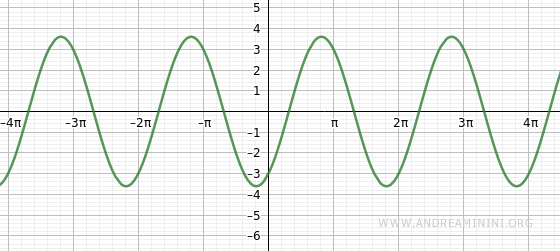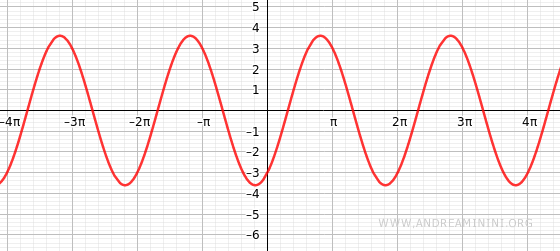Phase Angle in Trigonometry
In trigonometry, the phase angle is an angle that allows me to express a function $$ y = a \sin x + b \cos x $$ as an equivalent sinusoidal function $$ y = r \cdot \sin (x + k) $$
Here, k is the phase angle, and it is given by the arctangent of the ratio b/a.
$$ k = \arctan \frac{b}{a} $$
Meanwhile, r represents the amplitude of the sinusoid and is calculated as the square root of the sum of the squares of the coefficients, a2+b2.
$$ r = \sqrt{a^2 + b^2} $$
Thus, a function like sin(x) + cos(x) can be rewritten as a sinusoid by applying a horizontal shift of k and a vertical scaling of r.
$$ y = a \sin x + b \cos x = r \cdot \sin (x + k) $$
Using the formulas for r and k, the complete transformation formula is:
$$ y = a \sin x + b \cos x = \sqrt{a^2 + b^2} \cdot \sin (x + \arctan \frac{b}{a}) $$
Note: When using the transformation formula, make sure to keep the signs of coefficients a and b consistent with those in the original function. For instance, if the original function is $$ y= \sin x - \cos x $$ the coefficients are $$ a=1$$ and $$ b=-1 $$
A Practical Example
Consider a function where a=2 and b=3:
$$ y=2 \sin x - 3 \cos x $$
The graph of this function is shown below:

We want to express it in its equivalent form:
$$ y = r \sin (x + k) $$
The phase angle k is calculated as the arctangent of b/a:
$$ k = \arctan \frac{b}{a} = \arctan \frac{-3}{2} = -0.98 \ rad \ (approximately \ -56.3°) $$
The amplitude r is found as the square root of a2+b2:
$$ r = \sqrt{a^2+b^2} = \sqrt{2^2+3^2} = \sqrt{4+9} = \sqrt{13} $$
Therefore, the equivalent function is:
$$ y = \sqrt{13} \cdot \sin (x + (-0.98 \ rad )) $$
$$ y = \sqrt{13} \cdot \sin (x - 0.98 \ rad) $$
This results in a scaling of √13 and a shift of -0.98 radians (about -56.3°).
The graph of the transformed sinusoidal function matches the original one.

The Proof
The formula I want to demonstrate is a sinusoidal function:
$$ y = r \sin (x+k) $$
I apply the sine addition formula:
$$ y = r \cdot [ \sin x \cos k + \sin k \cos x ] $$
$$ y = r \sin x \cos k + r \sin k \cos x $$
I assign the two terms to the variables a and b:
$$ a = r \cos k $$
$$ b = r \sin k $$
This allows me to rewrite the function in its equivalent form:
$$ y = a \sin x + b \cos x $$
For this form to be equivalent, the coefficients a and b must satisfy the following system:
$$ \begin{cases} a = r \cos k \\ \\ b = r \sin k \end{cases} $$
I square both sides of each equation:
$$ \begin{cases} a^2 = r^2 \cos^2 k \\ \\ b^2 = r^2 \sin^2 k \end{cases} $$
I then add the equations together:
$$ a^2 + b^2 = r^2 \cos^2 k + r^2 \sin^2 k $$
$$ a^2 + b^2 = r^2 ( \cos^2 k + \sin^2 k ) $$
According to the Pythagorean identity, the sum of the squares of the cosine and sine is one: cos2+sin2=1
So, the equation simplifies to:
$$ a^2 + b^2 = r^2 $$
Taking the square root of both sides:
$$ \sqrt{a^2 + b^2} = \sqrt{r^2} $$
$$ \sqrt{a^2 + b^2} = r $$
Thus, I’ve determined the value of r, the amplitude of the sinusoid.
To find the angle k, I revisit the system of equations:
$$ \begin{cases} a = r \cos k \\ \\ b = r \sin k \end{cases} $$
Next, I divide both equations:
$$ \frac{b}{a} = \frac{r \sin k}{r \cos k} $$
$$ \frac{b}{a} = \frac{\sin k}{\cos k} $$
$$ \frac{b}{a} = \tan k $$
Applying the arctangent to both sides:
$$ \arctan \frac{b}{a} = \arctan \tan k $$
$$ \arctan \frac{b}{a} = k $$
Thus, I’ve also found the phase angle k of the sinusoid.
$$ k = \arctan \frac{b}{a} $$
And so forth.
